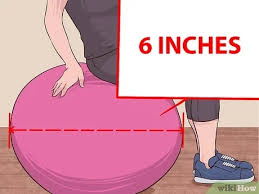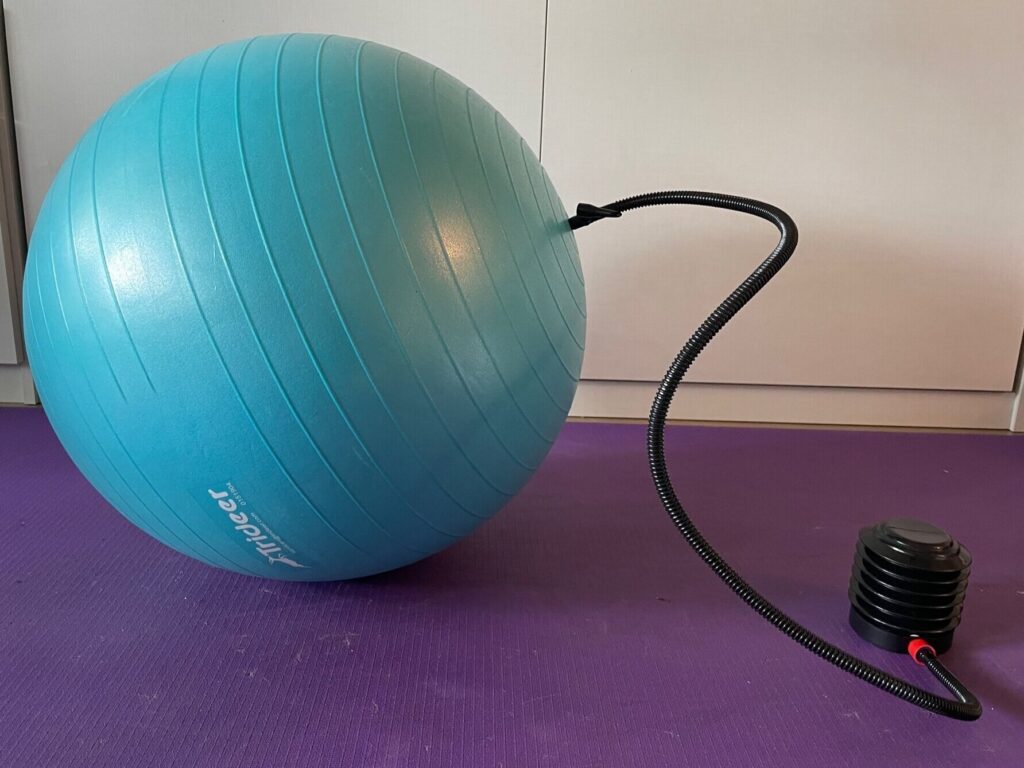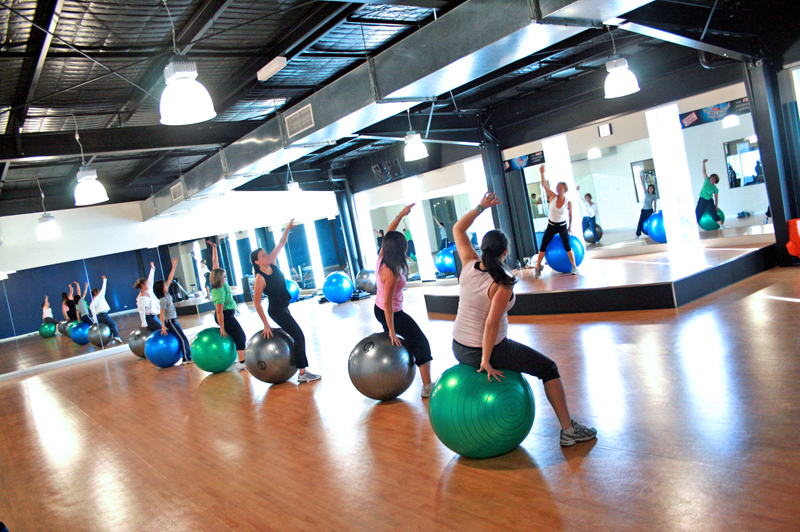How to Choose the Right Size Exercise Ball for Stability Workouts
Exercise balls, known as stability balls, Swiss balls, or physio balls, are versatile pieces of equipment used in different fitness routines, including strength training and balance improvement, among other rehabilitation exercises. To maximize benefits and safety during a workout session, it is essential to select the correct size of an exercise ball.
In this comprehensive guide, we will explore everything one needs to know about how to choose the right size exercise ball for stability workouts, which includes height consideration, firmness of the ball, intended usage, and other tips for maintaining and using your exercise ball effectively.
Understanding Exercise Balls

What is a Stability Ball?
A stability ball refers to an enormous inflatable object made from elastic yet soft material such as PVC. These balls come in various sizes and have found their way into physical therapy sessions and athletic training kits among general fitness regimes for purposes of improving flexibility, balance, strength, and coordination. Exercise on such a surface forces more than one group of muscles to engage at once, making workouts more difficult but more efficient.
Choosing the Right Size Stability Ball
One should be careful when selecting a stability ball because choosing anything that doesn’t fit properly can affect posture negatively, besides being ineffective for exercising or becoming detrimental.
This article expounds on how to make the right selection regarding your stability workout size. The most important factors include your height and the kinds of activities you want to undertake.
Exercise Ball Sizing Chart
The table below provides approximate measurements based on height:
Under 4’8″ (142 cm): 45 cm orb
4’8″–5’3″ (142–160 cm): 55 cm orb
5’4″–5’10” (160–178 cm): 65 cm orb
5’11” -6’4” (178-193 cm): 75 cm orb
Above 6’4” (193 cm): 85 cm orb
You can further understand it in this way
Less than 5’0” (152 cm): 45 cm ball
5’0”–5’5” (152–165 cm): 55 cm ball
5’6”–5’11” (166–180 cm): 65 cm ball
6’0”–6’4” (181–193 cm): 75 cm ball
Over 6’4” (193 cm): 85 cm ball
These sizes are only estimates and can vary depending on personal body proportions and preferences.
How to Measure Your Stability Ball Size

To verify that it is the right size, sit on a ball with your feet flat on the ground. Also, thighs should be parallel to the floor, or knees should be bent at an angle of 90 degrees. If your hips are below your knees, then it’s clear that you need the smaller ball. If your hips are above your knees, it is certainly too large for you. This understanding is crucial when figuring out how to choose the correct-sized exercise balls for stability workouts.
Dear reader, when we learn How to Choose the Right Size Exercise Ball for Stability Workouts, we must talk about inflating your exercise ball.
Inflating Your Exercise Ball
Safe and effective use of an exercise ball requires proper inflation. Consider these steps for the best inflation results:
Initial Inflation:
Inflate to about 80% of its maximum diameter so that the material can stretch and settle.
Rest period:
Wait for 24 hours before blowing more air into this ball. This step helps prevent over-expansion and bursting cases.
Final Inflation:
Fill up the ball until it is firm but still has a little give in it by using a tape measure to measure its diameter.
Check Firmness:
Push on top of a fitness tool. It must acquire some shape alteration under load but not flatten completely.
Tools for Inflation

The inflation process becomes easier and more accurate if one uses an electric air pump or hand pump device during inflation. Some stability balls come along with their pumps, while others may require you to buy them separately, hence creating another task: how to select proper-sized exercise balls as far as stability workouts are concerned.
Verifying Proper Inflation
To check if the ball is inflated enough to sit on, please sit on it and ensure your knees are at the right angle. The ball should be stable but a little springy in feeling. Overinflating the ball will make it too hard to use and increase slipping chances.
The problem with under-inflation is that it makes it too soft, thus affecting its effectiveness and support. Proper inflation is important because it helps you choose the right size exercise ball for stable workouts.
Different Uses for Exercise Balls

Stability Balls for the Office
You can improve your posture by using a stability ball as a chair while working out your core muscles at the same time. When buying one for office use, consider:
The correct size:
Choose the accurate height for your desk.
Posture Check:
It must allow you to sit with both feet flat on the floor and your knees at a 90-degree angle.
Base or Frame:
Check other options, such as having a base or frame that will prevent balls from rolling away while improving their steadiness.
Benefits of Using a Stability Ball as a Chair
Better Posture:
Encourages sitting up straight instead of slumping forward.
Engages core muscles:
Activates trunk muscles, thereby providing subtle exercise over time.
Promotes active sitting:
stimulates active sitting that may counteract some negative effects that result from a sedentary lifestyle, like obesity and diabetes type II.
Stability Balls for the Home
Choose carefully according to where you will use it and what kind of exercises you plan to do. For most adults starting out, they need something versatile, about 65 cm across. Home workouts include:
Core Workouts:
Exercises involving crunches, planks, and bridges, among others.
Strength Training:
Squats, lunges, and push-ups with added instability provided by balls.
Flexibility Exercises:
Stretching or yoga routines using balls effectively serve this purpose.
Creating a Home Workout Routine
Warm-Up:
Begin with light cardio or stretching to limber up your body.
Core Exercises:
Engage your core muscles through moves such as ball crunches and planks.
Strength Training:
Intensify resistance training by adding instability using a ball, which also works the stabilizing muscles in your body.
Cool Down:
Finish with some stretches that are aimed at increasing flexibility and reducing muscle stiffness.
Stability Balls for the Gym

Gyms use stability balls for various exercises. When purchasing one for the gym, consider:
Durability:
It should be puncture-resistant and durable since it is used by multiple users.
Size Variety:
For instance, taller people may benefit from larger balls, while other exercises may call for more stability than small-size balls can provide.
Availability:
Different sizes must be found within gyms to fit various users and workout types.
Gym Workout Ideas with Stability Balls
Balance Training:
Improve balance and coordination through exercises like single-leg squats on a ball.
Functional Training:
Full-body workouts simulate everyday activities while using a ball as part of them.
Rehabilitation:
The ball is used for gentle exercises during recovery or rehabilitation exercises when low-impact activities are desired.
Specialized Exercises with Stability Balls
Exercise Ball Therapy for Lower Back Pain Relief
Using an exercise ball can help alleviate lower back pain by:
Building Core strengths:
Muscles that hold your spine become stronger because of this method of exercise therapy.
Increasing Flexibility:
the looseness of tight muscles that in turn enhances full-range motion.
Promoting good posture:
Promoting good posture encourages alignment, thus relieving strain on the back muscles.
Lower Back Stabilization Exercises
Pelvic Tilts:
Gently tilt your pelvis forward and then backward to engage your lower back muscles while seated on the ball.
Back extensions:
Place your stomach over the ball and lift the upper body, focusing on the lower back muscles.
Bridge:
Lie on your back with your feet on a ball and lift your hips off the ground to create a bridge-like body shape.
Core Strength Exercises

Strengthening the core muscles is important for overall stability and balance. Some of the best exercises for core strength include:
Ball Crunches:
Do crunches on top of a ball, ensuring that your abdominal muscles are fully engaged.
Plank Holds:
Challenge your balance by keeping either your hands or feet rested on a ball while holding a plank position.
Russian Twists:
Twist your upper body to one side, then twist it to the other side while seated on top of an exercise ball, holding either a weight or medicine ball for added resistance.
Exercise Ball and Back Pain
Here is how incorporating an exercise ball into the routine can help in managing and preventing such pains as:
Improving Muscle Balance:
It helps in developing all muscles evenly to avoid creating imbalances leading to pain.
Relieving Pressure:
Exercising without adding stress to the spine using a low-impact support surface.
Promoting Mobility:
It helps prevent stiffness which is very essential towards having a healthy back.
Additional Tips for Exercise Balls

Safety Precautions
Use on Non-Slip surfaces:
Before you begin exercising, make sure that you place it in an area where it cannot slide away easily.
Check for Damage:
Take time regularly to examine whether there are any signs of tear or wear on its surface.
Keep it in a cool, dry place when not in use. By avoiding direct sunlight exposure and shielding it from sharp objects, it will last longer.
Reinflate when necessary.
Sometimes, its air might reduce with time. Regularly check its firmness & reinsulate if need be so that you can maintain the right size & density.
May you read this also: https://drreactivate.com/how-to-use-resistance-bands-for-full-body-workouts-at-home/
Conclusion
It is crucial to know how to select an appropriate-sized fitness ball for stability training if we want effective results and safety measures. You will choose the perfect one among them by considering factors such as your height, the type of exercises you will do, and how to inflate them properly.
Be it for office use, home use, or gym workouts, a well-chosen stability ball can help you during your exercise routines by improving your posture and relieving back pain conditions.
Your fitness arsenal is not complete without an exercise ball, which, when taken care of, will serve you for many years.
To summarize, ways of selecting the perfect-sized exercise balls for stability training include:
Measuring Your Height and Proportions: Use the chart to check for the corresponding size depending on how tall you are.
Get Proper Inflation:
Ensure that it has been inflated to the recommended size and that its firmness is right as per reference figures.
Choosing Your Environment:
Purchase one that matches your surroundings, whether it is meant for the workplace, home use, or gym session.
Maintaining a Fitness Ball:
Look out for any wear signs, keep it clean, and store it accurately so that its life span can be prolonged.
With this knowledge, you will easily find suitable-sized exercise balls for stability workouts, hence making your exercising time effective without any harm to yourself or anything else around.
The correct training ball can transform your experience at the gym since it provides both support and challenge, helping you achieve fitness objectives more easily.
Q1: Why is it important to choose the right size exercise ball for a stability workout?
To get the right size exercise ball, you need to ensure good alignment and posture during workouts for effective exercise and injury prevention.
Q2: How do I know if the exercise ball is the correct size?
When using this ball as a seat, your thighs must be horizontal on it, with your knees forming a 90-degree angle. Moreover, your hips should either be at the same level or slightly above those of your knees.
Q3: What if you are in the middle of two sizes? Should I choose the smaller or larger exercise ball?
It depends on the kind of exercises you want to do, and so if you are between sizes, think about that. The bigger one is for more stability and balance, while the smaller one is for some very challenging balancing exercises. You can also blow it up or deflate it a bit to adjust the firmness and size.
Q4: What impact does the exercise ball’s level of rigidity have on its utility?
A harder one gives more stability; therefore, it works great as a chair and during core workouts. A less hard ball is unstable, making balance exercises difficult and activating more muscles.
Q5: Can an individual change the size of his/her exercise ball after purchase?
Indeed, by inflating or deflating it, you will be able to adjust this point with ease. Therefore, be cautious not to add too much air because this could lead to rupturing; thus, follow all manufacturer guidelines while doing this.
Q6: Are there any particular requirements to observe when using a birthing ball during pregnancy?
During pregnancy, it is essential to ascertain that the ball size is correct for adequate support. Bigger and harder balls may provide better stability. Always consult with your healthcare provider before commencing any exercise program when pregnant.
Q7: How can I take care of my exercise ball so that it lasts?
Keep away from sharp objects and direct sunlight, which might weaken the material. It should be cleaned regularly using a mild soap and a damp cloth. The ball should also be checked periodically for wear or tear signs.
Q8: Does the size of an exercise ball have any impact on my workout results?
Yes, ensuring that you utilize the right dimensions for an exercise ball guarantees proper posture and alignment which is crucial to hitting desired muscles as well as preventing strains or injuries, thereby leading to better performances from your workouts.

